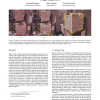ISMAR
2007
IEEE
14 years 6 months ago
2007
IEEE
In this paper we present the process of designing and developing a fully functional and interactive AR handheld device. Based on a human-centered approach we describe the results ...
ISMAR
2007
IEEE
14 years 6 months ago
2007
IEEE
In this article we present interactive Focus and Context (F+C) visualizations for Augmented Reality (AR) applications. We demonstrate how F+C visualizations are used to affect the...
ISMAR
2007
IEEE
14 years 6 months ago
2007
IEEE
Tangible Augmented Reality (AR) systems imbue physical objects with the ability to act and respond in new ways. In particular, physical objects and gestures made with them gain me...
ISMAR
2007
IEEE
14 years 6 months ago
2007
IEEE
ISMAR
2007
IEEE
14 years 6 months ago
2007
IEEE
We propose a novel, low-complexity, tracking scheme that uses motion vectors directly from a video coder. We compare our tracking algorithm against ground truth data, and show tha...
ISMAR
2007
IEEE
14 years 6 months ago
2007
IEEE
We present a non-rigid registration technique that achieves spatial, photometric, and visibility accuracy. It lets us photo-realistically augment 3D deformable surfaces under comp...
ISMAR
2007
IEEE
14 years 6 months ago
2007
IEEE
In this paper we present an innovative adaptive imperceptible pattern projection technique that takes into account parameters of human visual perception. A coded image is temporal...
ISMAR
2007
IEEE
14 years 6 months ago
2007
IEEE
3D graphics systems increasingly rely on sophisticated event systems derived from collision detection mechanisms, which support the discretisation of Physics as well as high-level...
ISMAR
2007
IEEE
14 years 6 months ago
2007
IEEE
In this paper we present the evaluation of a virtual mirror used as a navigational tool within a medical augmented reality (AR) system for laparoscopy. 12 surgeons of our clinical...
ISMAR
2007
IEEE
14 years 6 months ago
2007
IEEE
Ubiquitous tracking setups, covering large tracking areas with many heterogeneous sensors of varying accuracy, require dedicated middleware to facilitate development of stationary...






